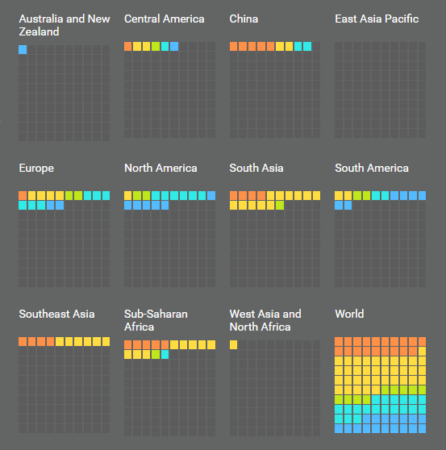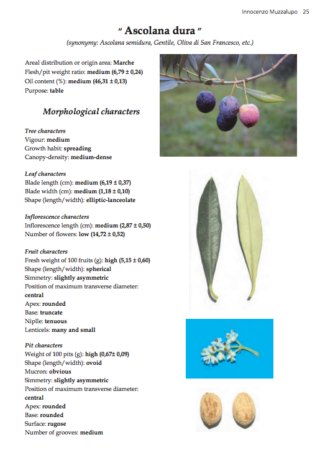 Call me a dinosaur, but I like this sort of stuff. A proper printable catalogue of all the material in a collection, with photographs and all, in this case the 200+ olive varieties in Italy’s Centro di Ricerca per l’Olivicoltura e l’Industria Olearia. ((Don’t worry, there’s biochemical and molecular stuff on the second page of each variety entry.)) No doubt all the info is in the appropriate database, where it can be compared to the holdings of other institutes and all. But I’m still grateful for the PDF version.
Call me a dinosaur, but I like this sort of stuff. A proper printable catalogue of all the material in a collection, with photographs and all, in this case the 200+ olive varieties in Italy’s Centro di Ricerca per l’Olivicoltura e l’Industria Olearia. ((Don’t worry, there’s biochemical and molecular stuff on the second page of each variety entry.)) No doubt all the info is in the appropriate database, where it can be compared to the holdings of other institutes and all. But I’m still grateful for the PDF version.
Nibbles: Aeroponic yams, Ancient crops, Kumara, Informal food vendors, Foxy, Salumi, Corn whiskey, Doomed cassava
- Yams up in the air, but in a good way.
- Yet another couple of things on how “ancient crops” will save us all. All crops are ancient. Well, except the kiwi.
- Lovely little film on a lovely sweet-potato-growing New Zealand couple to make up for that uncalled-for dig at the kiwi. Made my day.
- Engage with kiosk holders, don’t hassle them.
- Review of a book on the quixotic attempt to resynthesize the dog. Why bother?
- More Italian salami than you can shake a stick at.
- Might go well with some artisanal Mexican corn whiskey.
- Cassava is “pointed in the direction of extinction.” Thank goodness for genebanks, eh?
Brainfood: Dope diversity, Potato chips, Conservation costing, Island breeding systems, Indus civilization cereals, Drone phenotyping, Wild rice in Asia, Wild rice & Native Americans, Pearl millet temperature, Climate change & fruit/veg
- Cannabis Domestication, Breeding History, Present-day Genetic Diversity, and Future Prospects. The traditional landraces are being contaminated and need urgent collection and evaluation by dedicated professionals.
- Cold sweetening diversity in Andean potato germplasm from Argentina. 5 out of 48 Andigena landraces make good chips.
- Considering cost alongside the effectiveness of management in evidence-based conservation: A systematic reporting protocol. Here comes the metadata. No excuse now.
- Self-compatibility is over-represented on islands. 66% vs 41% in Asteraceae, Brassicaceae and Solanaceae. Any crop wild relatives in the list?
- Cereals, calories and change: exploring approaches to quantification in Indus archaeobotany. Millet may not have been as important as is generally thought.
- High-Throughput Phenotyping of Sorghum Plant Height Using an Unmanned Aerial Vehicle and Its Application to Genomic Prediction Modeling. A near-infrared, green and blue (NIR-GB) camera on a drone gives pretty good results compared to a person with a tape measure, and is much more fun.
- Asian wild rice is a hybrid swarm with extensive gene flow and feralization from domesticated rice. No such thing as completely wild Asian rice.
- The dispute over wild rice: an investigation of treaty agreements and Ojibwe food sovereignty. Not wild rice at all, but what’s been happening to it might be a violation of the White Pine Treaty with the Ojibwe.
- Quantifying pearl millet response to high temperature stress: thresholds, sensitive stages, genetic variability and relative sensitivity of pollen and pistil. The problem is the pistils.
- Effect of environmental change on yield and quality of fruits and vegetables: two systematic reviews and projections of possible health effects. Bad for yield, good for nutritional quality.
Everything about size
Whizz-bang websites in support of data-dense papers seem to be all the rage.
Remember “Farming and the geography of nutrient production for human use: a transdisciplinary analysis,” published in the inaugural The Lancet Planetary Health a couple of weeks back? We included it in Brainfood, and linked to an article by Jess Fanzo which summarizes the main findings. This is probably the money quote:
Both small and large farms play important roles in ensuring we have enough food that is diverse and nutrient-rich. While industrialised agriculture suggests domination of food systems, smallholder farms play a substantial role in maintaining the genetic diversity of our food supply, which results in both benefits and risk reductions against nutritional deficiencies, ecosystem degradation, and climate change. Herrero and colleagues argue that if we want to ensure that the global food supply remains diverse and generates a rich array of nutrients for human health, farm landscapes must also be diverse and serve multiple purposes.
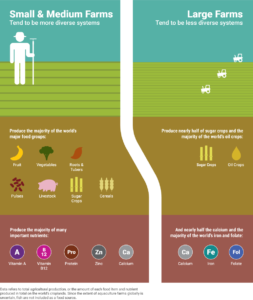 Well, there’s also a graphics-rich website now, “Small Farms: Stewards of Global Nutrition?” The infographic at the left here puts it in the proverbial nutshell (click to embiggen).
Well, there’s also a graphics-rich website now, “Small Farms: Stewards of Global Nutrition?” The infographic at the left here puts it in the proverbial nutshell (click to embiggen).
But what you really want to know is on what kinds of farms are grown those Canadian and Indian peas we talked about yesterday in connection with other fancy websites. Well, unfortunately, the data are only available for “pulses” here, but, perhaps unsurprisingly, those are grown mainly on large(ish) farms (blue) in North America, and small(ish) farms (orange) in South Asia. Each square is 1% of global production.
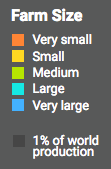 You can get similar breakdowns for different food groups (cereals, oils, etc.), and for a bunch of different nutrients: Calcium, Calories, Folate, Iron, Protein, Vitamin A, Vitamin B12, and Zinc. For all of these last you can also see global maps of nutritional yields, or “the number of people who can meet their nutritional needs from all of the crops, livestock, and fish grown in an area.” Here’s the one for Vitamin A.
You can get similar breakdowns for different food groups (cereals, oils, etc.), and for a bunch of different nutrients: Calcium, Calories, Folate, Iron, Protein, Vitamin A, Vitamin B12, and Zinc. For all of these last you can also see global maps of nutritional yields, or “the number of people who can meet their nutritional needs from all of the crops, livestock, and fish grown in an area.” Here’s the one for Vitamin A.
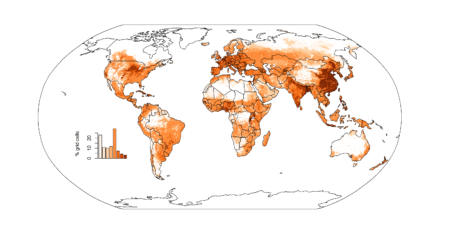
Which I’m sure will be of use in targeting the promotion of homegardening, say, or the roll-out of things like orange sweet potatoes. There is Biofortification Priority Index already, but only at a fairly coarse, country level. As far as I know, anyway.
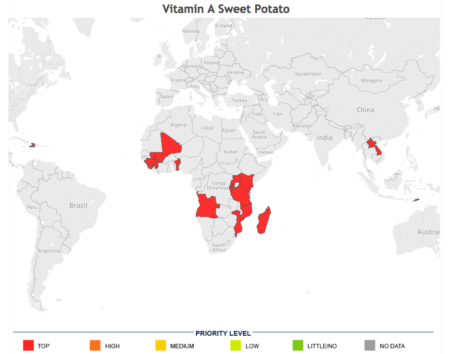
Of course, those countries could always import sweet potatoes…
Canadian peas in India
Speaking of nifty websites, I’ve just come across resourcetrade.earth, from Chatham House, which enables
…users to explore the fast-evolving dynamics of international trade in natural resources, the sustainability implications of such trade, and the related interdependencies that emerge between importing and exporting countries and regions.
That of course includes agricultural trade, with the data coming mainly from FAO and USDA. Which means you can do interesting mash-ups with the global diets data we blogged about a couple of days back.
 For example, here on the left are the data on the contribution of pulses to total food weight in the Indian diet, courtesy of that fabulous CIAT website. Note the steady increase in pea consumption over the past 30 years or so (click on the image to make it bigger, it’s the plot in the bottom right hand corner).
For example, here on the left are the data on the contribution of pulses to total food weight in the Indian diet, courtesy of that fabulous CIAT website. Note the steady increase in pea consumption over the past 30 years or so (click on the image to make it bigger, it’s the plot in the bottom right hand corner).
A lot of those peas, it turns out, now come from abroad, Canada mostly (as you can see on the map below). It’s a $500 million market, up from $30 million in 2000.
Now, I don’t know what proportion of Indian pea consumption is down to Canadian imports, but it should be possible to figure it out. I’m betting a fair bit of the aloo mutter you have in Amritsar is made in Canada.
